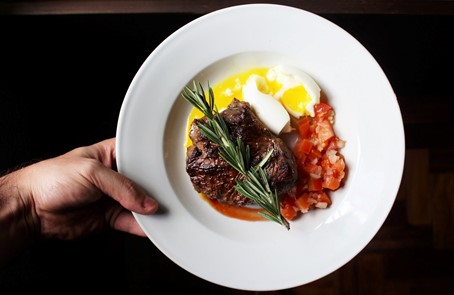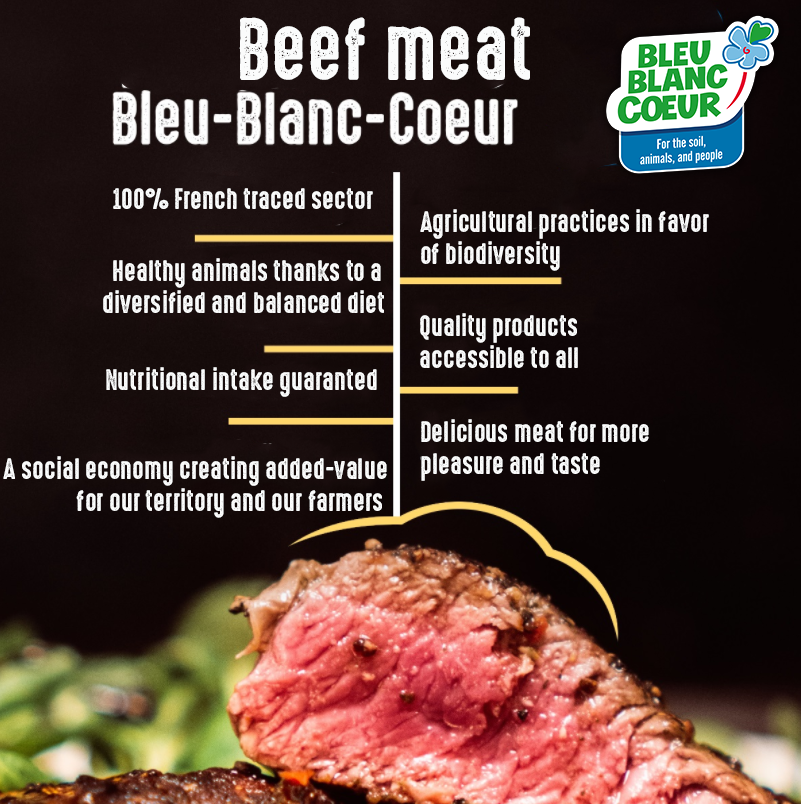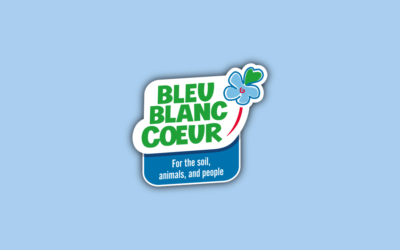Beef lovers are numerous, and lots of international traditional recipes bear witness to this: Churrasco, Pabellón criollo (in South America), Bulgogi, Rendang daging (in Asia), Flemish beef stew, Boeuf Bourguignon, Osso Buco (in Europe) and many others. The Beef is a product of quality to be included in our diet in the right proportion and to mix with complementary food for our nutritional balance. It’s also important to be interested in the way in which the meat was produced and its consequence on the resources of our territories. Feeding animals can promote their health and ours, but also limit our environmental impact; it’s in this logic that Bleu-Blanc-Cœur approach was built.
Let’s go back to the basics!
Ruminants are herbivorous mammals that have the common feature of having several organs related to stomachs within their digestive tract (including the rumen), as well as a very rich bacterial flora : this helps to well digest the fibers of grass and fodder. Rumination is the return of feed from the rumen to the mouth to be chewed and mixed well with saliva. The large ruminant family includes cattle with the cow and its ovine friends that are also loved for their wool (sheep, lamb, ewe), and the goat. Beef cattle are derived from animals of the species Bos taurus, whatever we speak about cows, bulls, veals, heifers or steers.

Limousines breed cows from Julien Boulet, Bleu-Blanc-Cœur breeder in France.
There are different cattle breeds, some are pampered much more for their ability to produce milk, and others for their quality of muscles which will give an appreciate meat. From this second category, it exists various reputed: Charolaise, Limousine, Blond d’Aquitaine, Angus, Aubrac, Wagyu, Asturiana, rubia Gallega, etc. The breeds used in breeding are often rooted in a peasant and culinary culture, specific to each region. That’s important to encourage these traditions to favorize the biodiversity between herds and preserve all the taste and nutritional nuances of beef meat.
A nutritional richness
The nutritional impact from beef meat depends on the piece of meat but also according to the way the animal has been fed: the choosing cereals and the possibility or not for grazing fresh grass.
On the nutrient side, we found in beef meat, proteins that we know well assimilate: between 20 and 40% according to the piece and the cooking methods. There are also lipids up to 5 to 20 %. Among these lipids, Omega-3, famous for their anti-inflammatory effects, may find their way in greater or lesser quantity into the cell membranes of cattle depending on how they have been fed. For example a Bleu-Blanc-Cœur flank-steack will obligatory have an Omega-3 content greater than 0.8% thanks to a balanced animal feed (having as example according the season grass and fodder, flaxseed, and rapeseed in good proportions). This Omega-3 content is an obligation of result writing in the Bleu-Blanc-Cœur Meat Beefproduction guideline. 0.8g of Omega-3 are therefore contained in a portion of 100gr of flanck-steack. It represents more than a third of the daily consumption recommendations for Omega -3 daily adults die, which are set at 2.2gr/day (reference from French National Agency for Food, Environmental and Occupational Health Safety). The ground beefsteak is less equipped with Omega-3 : in its standard version (with 15% of fat matter), it contain around 0.06g of Omega-3 but we double the amount by choosing it with the Bleu-Blanc-Cœur logo, while saturated fatty acids are reduced by 10% and Omega-6 (with pro-inflammatory effects) by around 30%. Beef meat is also well-supplied with micronutrients such as iron, zinc, and most of the vitamins constituting the B group, including Vitamin B12.

Minerals to watch out for
A ground beefsteak contains about 3.25mg of iron and a braised peace of equivalent size, up to 7.5mg ( that’s 3 times less for veal). Iron is a major actor for the transfer of oxygen that we breath to our cells. A regular Iron intake of 11mg/day in adult is recommended by the ANSES (French National Agency for Food, Environmental and Occupational Health Safety) and even 16 mg for pregnant women with heavy menstrual periods, because the menstruation causes iron losses. So-called « heme » iron from animal origin is much better assimilated than iron from plants but, consumed in too large proportions, its oxidizing power can become problematic. Indeed, the very large consumers of red meats (more than 500gr per week after cooking) are considered to be at greater risk to develop a colorectal cancer and having cardiovascular disorders. Rest assured, as example the average consumption level in France is around 52 g of red meats per day so less than 370 g per week for an adult.
What is a red Beef ?
According to the World Health Organization, Meat from beef, veal, pork, lamb, sheep, horse and goat are considered as red meat.
Let’s talk about Zinc!
Information by Alexandra Essen, micronutritionist and sophrologist.
At last 3 good reasons to be interested in zinc!
![]() Zinc helps to regulate oxidant stress and inflammation.
Zinc helps to regulate oxidant stress and inflammation.
Oxidative stress is caused by free radicals, oxygen-reactive elements that oxidize components of our cells. This lead to the accelerating aging and increases the risk to develop some diseases (cancers in particular). These radicals are formed during breathing and in greater quantity in the event of smoking, stress, pollution, etc. Zinc regulates the presence of these free radicals and of molecules involved in immunity to decrease the inflammation.
![]() Zinc contribute to reduce tiredness by helping the proper assimilation of carbohydrates and others nutrients.
Zinc contribute to reduce tiredness by helping the proper assimilation of carbohydrates and others nutrients.
![]() Zinc participates in the development and functioning of our nervous system.
Zinc participates in the development and functioning of our nervous system.
That’s not all ! Zinc also helps to fix phosphorus on the bones, helps heal wounds, and and is involved in the sperm production.
Which quantity consume?
Men : 12mg/day / Women : 10 mg/day
Pregnant women, lactating and elderly women: between 15 and 23 mg/day.As example, either 3 oysters, or 100g of cooked beef, or 200 g of cooked veal,or 70 g of wheat germ provident about 10 mg of zinc.
Before any use of food supplements, medical advice is necessary.
What food associate with beef meat?
Beef meat goes very well with vegetables. They contain antioxidants which can offset the pro-oxidant effect of heme iron. Calcium is also strong in this little game and that’s good news for lovers of good cheeseburgers (Parmesan, Gruyere, Comté, Emmental, Tomme Gouda, are well-equipped with calcium). May those who prefer granny’s stews be reassured because this method of cooking is very interesting: the sauce that forms on contact with the meat is full of minerals and vitamins which diffuse gently during cooking; if the meat is cooked with the bone (#ossobuco), it’s even better because it’s gets the calcium in bonus. More simply, a parmesan dose on your Pasta Bolognese or a small piece of cheese after the main course is good too.

Commit to the Planet
Beef Cattle able to graze and feed with varied cereals and fodders locally produced are also gentler on the planet! If the herd benefits from a diet well-supplied with Omega-3 (we found it in good quantity into grass, flax, rapeseed, alfalfa, etc.). Then the quantity of methane belched during rumination decreases: About – 10% of methane over the feeding period of animals following Bleu-Blanc-Cœur approach. In addition, thanks to, this natural diet, cattle look great with a bacterial flora that « goes wild » and veterinarians have less need to prescribe drugs because their immunity is strengthened.

Sources :
- Bleu-Blanc-Cœur beef production guideline
- French Society of nutrition : «Place of red-meat in a good diet » original version in French « Place de la viande rouge dans une bonne alimentation »
- www.anses.fr






 Home
Home

